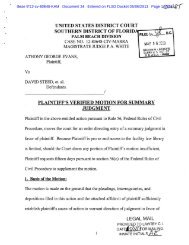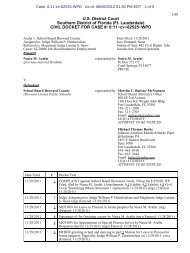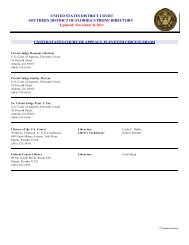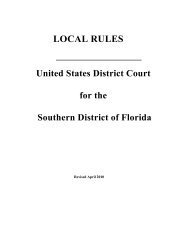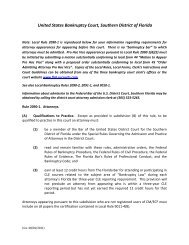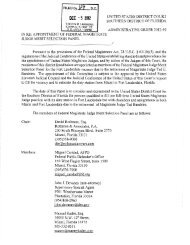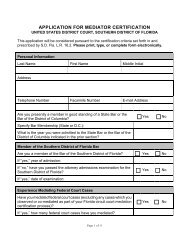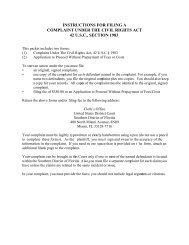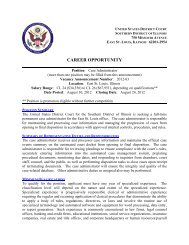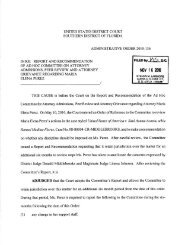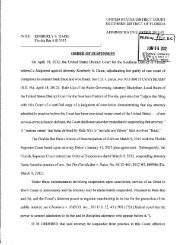JAN j 6 2010 - United States District Court
JAN j 6 2010 - United States District Court
JAN j 6 2010 - United States District Court
Create successful ePaper yourself
Turn your PDF publications into a flip-book with our unique Google optimized e-Paper software.
discovery or for a protective order, the party from whom discovery is<br />
sought must show that the information is not reasonably accessible<br />
because of undue burden or cost. If that showing is made, the <strong>Court</strong> may<br />
nonetheless order discovery from such sources if the requesting party<br />
shows good cause, considering the limitations of Federal Rule of Civil<br />
Procedure 26(b)(2)(C). The <strong>Court</strong> may specify conditions for the<br />
discovery. Absent exceptional circumstances, the <strong>Court</strong> may not impose<br />
sanctions under these Local Rules on a party for failing to provide<br />
electronically stored information lost as a result of the routine,<br />
good-faith operation of an electronic information system.<br />
Discovery Motions.<br />
3rv-(l) Time for Filing. All motions related to discovery, including but<br />
not limited to motions to compel discovery and motions for protective<br />
order, shall be filed within thirty (30) days of the occurrence of<br />
grounds for the motion. Failure to file ^discovery motion within thirty<br />
(30) days, absent a showing of reasonable cause for a later filing, may<br />
constitute a waiver of the relief sought.<br />
3-r(2) Motions to Compel. Except for motions grounded upon complete<br />
failure to respond to the discovery sought to be compelled or upon<br />
assertion of general or blanket objections to discovery, motions to<br />
compel discovery in accordance with Federal Rules of Civil Procedure 33,<br />
34, 36 and 37, or to compel compliance with subpoenas for production or<br />
inspection pursuant to Federal Rule of Civil Procedure 45(c)(2)(B),<br />
shall, for each separate interrogatory, question, request for production,<br />
request for admission, subpoena request, or deposition question, state:<br />
4a4-(A) verbatim the specific item to be compelled,- 4fe4-(B) the specific<br />
objections; 4e4-(C) the grounds assigned for the objection (if not<br />
apparent from the objection) ; and 4eB-(D) the reasons assigned as<br />
supporting the motion as it relates to that specific item. The party<br />
shall write this information in immediate succession (e.g., specific<br />
request for production, objection, grounds for the objection, reasons to<br />
support motion; next request for production, objection, grounds for the<br />
objection, reasons to support motion; and so on) to enable the <strong>Court</strong> to<br />
rule separately on each individual item in the motion.<br />
•3-r(3) Motions for Protective Order. Except for motions for an order to<br />
protect a party or other person from whom discovery is sought from having<br />
to respond to an entire set of written discovery, from having to appear<br />
at a deposition, or from having to comply with an entire subpoena for<br />
production or inspection, motions for protective order under Federal Rule<br />
of Civil Procedure 26 (c) shall, for each separate interrogatory question,<br />
request for production, request for admission, subpoena request, or<br />
deposition question, state: 4a^-(A) verbatim the specific item of<br />
discovery; 4&f (B) the type of protection the party requests; and 4&HC)<br />
the reasons supporting the protection. The party shall write this<br />
information in immediate succession (e.g., specific request for<br />
protection, protection sought for that request for production, reasons to<br />
support protection; next request for production, protection sought for<br />
that request for production, reasons to support protection; and so on)<br />
to enable the <strong>Court</strong> to rule separately on each individual item in the<br />
motion.<br />
55



